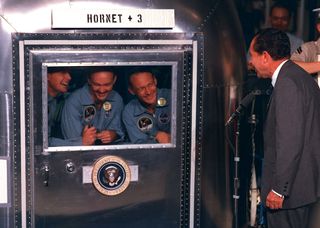Apollo 11 Flight Log, July 24, 1969: Return to Earth
Click unmute on the video above hear mission audio from Flight Day 9 -- Landing Day! -- of the Apollo 11 mission and listen to over 50 minutes of audio in the video from NASA below.
This summer marks the 50th anniversary of NASA's Apollo 11 mission. Fifty years ago today (July 24), the Apollo 11 astronauts separated the command module from the service module, re-entered Earth’s atmosphere, and safely landed home where they went to spend the next couple of weeks in quarantine to ensure that they hadn't brought back any "moon bugs." Here's how it happened.
After an eventful journey to and from the moon that included the first human footsteps on the lunar surface, the Apollo 11 crew prepared for a splashdown on Earth on the final day of their mission. Riding inside the command module Columbia were Neil Armstrong (commander), Buzz Aldrin (lunar module pilot) and Michael Collins (command module pilot).
The Apollo 11 crew woke up at 6:47 a.m. EDT to get ready for their landing. The first major milestone took place at 12:21 p.m., when they separated the command module from the "service module", which carried items such as oxygen tanks and electrical systems that were intended to keep the command module working properly during its journey to the moon and back.
- Relive the Apollo 11 Moon Landing Mission in Real Time
- Apollo 11 at 50: A Complete Guide to the Historic Moon Landing
- Apollo 11 Moon Landing Giveaway with Simulation Curriculum & Celestron!
Columbia entered Earth's atmosphere at 12:35 p.m., at times heating up so much that communications were interrupted by the supercharged atmosphere surrounding the spacecraft. But all went to plan. It safely splashed down about 950 miles (1,527 kilometers) southwest of Honolulu and only 15 miles (24 kilometers) from recovery ship USS Hornet.

The crew waited as recovery operations approached the spacecraft, opened the hatch and put isolation suits inside for the crew to wear, just in case they brought microbes back from the moon. They were also sprayed with disinfectant. Ultimately, the Apollo 11 crew went through customs in Hawaii after they reached land. They declared moon rocks and moon dust among their items.
Apollo 11 Flight Log:
July 23, 1969: Preparing for Landing
July 22, 1969: Firing Engines for Earth Return
July 21, 1969: Launching from the Moon
July 20, 1969: The Moon Landing
July 19, 1969: Live TV from Near the Moon
July 18, 1969: Entering the Moon's Gravity
July 17, 1969: Course Correction to Reach the Moon
July 16, 1969: Launch Day
Get the Space.com Newsletter
Breaking space news, the latest updates on rocket launches, skywatching events and more!
Follow Elizabeth Howell @howellspace, or Space.com @Spacedotcom. We're also on Facebook and Google+.
Join our Space Forums to keep talking space on the latest missions, night sky and more! And if you have a news tip, correction or comment, let us know at: community@space.com.

Elizabeth Howell (she/her), Ph.D., is a staff writer in the spaceflight channel since 2022 covering diversity, education and gaming as well. She was contributing writer for Space.com for 10 years before joining full-time. Elizabeth's reporting includes multiple exclusives with the White House and Office of the Vice-President of the United States, an exclusive conversation with aspiring space tourist (and NSYNC bassist) Lance Bass, speaking several times with the International Space Station, witnessing five human spaceflight launches on two continents, flying parabolic, working inside a spacesuit, and participating in a simulated Mars mission. Her latest book, "Why Am I Taller?", is co-written with astronaut Dave Williams. Elizabeth holds a Ph.D. and M.Sc. in Space Studies from the University of North Dakota, a Bachelor of Journalism from Canada's Carleton University and a Bachelor of History from Canada's Athabasca University. Elizabeth is also a post-secondary instructor in communications and science at several institutions since 2015; her experience includes developing and teaching an astronomy course at Canada's Algonquin College (with Indigenous content as well) to more than 1,000 students since 2020. Elizabeth first got interested in space after watching the movie Apollo 13 in 1996, and still wants to be an astronaut someday. Mastodon: https://qoto.org/@howellspace
